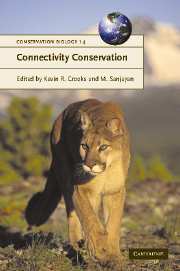Book contents
- Frontmatter
- Contents
- List of contributors
- Acknowledgements
- 1 Connectivity conservation: maintaining connections for nature
- PART I Approaches to connectivity research
- PART II Assessing connectivity
- Introduction: evaluating and quantifying the conservation dividends of connectivity
- 12 Quantifying connectivity: balancing metric performance with data requirements
- 13 Assessing connectivity in salmonid fishes with DNA microsatellite markers
- 14 Individual-based modeling as a tool for conserving connectivity
- 15 Linking connectivity to viability: insights from spatially explicit population models of large carnivores
- 16 Impacts of corridors on populations and communities
- 17 Exploring the functional connectivity of landscapes using landscape networks
- PART III Challenges and implementation of connectivity conservation
- Index
- References
15 - Linking connectivity to viability: insights from spatially explicit population models of large carnivores
Published online by Cambridge University Press: 24 May 2010
- Frontmatter
- Contents
- List of contributors
- Acknowledgements
- 1 Connectivity conservation: maintaining connections for nature
- PART I Approaches to connectivity research
- PART II Assessing connectivity
- Introduction: evaluating and quantifying the conservation dividends of connectivity
- 12 Quantifying connectivity: balancing metric performance with data requirements
- 13 Assessing connectivity in salmonid fishes with DNA microsatellite markers
- 14 Individual-based modeling as a tool for conserving connectivity
- 15 Linking connectivity to viability: insights from spatially explicit population models of large carnivores
- 16 Impacts of corridors on populations and communities
- 17 Exploring the functional connectivity of landscapes using landscape networks
- PART III Challenges and implementation of connectivity conservation
- Index
- References
Summary
INTRODUCTION
Increasingly, conservation groups and agencies attempt to create regional reserve designs that move beyond a simple aggregation of important sites to form a biologically functional network. As natural habitats are converted for human uses, remaining natural areas simultaneously become smaller and more isolated, reflecting the twin processes of habitat reduction and fragmentation (Wilcove et al. 1986). Maintaining connectivity between these remnant natural habitat patches is important for several reasons (Crooks and Sanjayan Chapter 1); on a timescale of generations, a single reserve or patch of natural habitat is unlikely to be large enough to sustain populations of area-sensitive species that are subject to the processes of demographic and environmental stochasticity (Harrison 1994); on a timescale of tens of generations, a single reserve may not be large enough to sustain a population's genetic diversity and maintain evolutionary processes, or allow the species to shift its range in response to long-term environmental trends such as climate change (Frankel and Soulé 1981).
Early literature on assessing landscape connectivity (e.g., Forman and Godron 1986) focused primarily on classifying landscape structure rather than relating this structure to population dynamics of particular species (Hanski 1994; Tischendorf and Fahrig 2000; Moilanen and Hanski 2001). In contrast, functional connectivity, at the scale discussed in this chapter, is a population-level process that implies that individuals of a species successfully disperse between connected patches and survive to breed in the destination patch.
- Type
- Chapter
- Information
- Connectivity Conservation , pp. 369 - 389Publisher: Cambridge University PressPrint publication year: 2006
References
- 11
- Cited by

